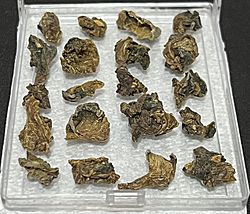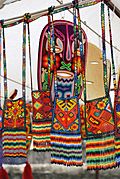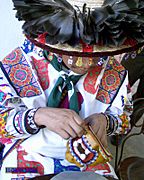Peyote facts for kids
Quick facts for kids Peyote |
|
|---|---|
 |
|
| Peyote in the wild | |
| Conservation status | |
| Scientific classification | |
| Genus: |
Lophophora
|
| Species: |
williamsii
|
| Synonyms | |
|
Echinocactus williamsii Lemaire ex Salm-Dyck |
|
The peyote (Lophophora williamsii) is a small cactus that does not have spines. It is known for its special compounds that have been used for a very long time in traditional practices. The word peyote comes from a Nahuatl word that means "caterpillar cocoon."
Peyote grows naturally in Mexico and the southwestern part of Texas. You can often find it in desert areas like the Chihuahuan Desert. It usually blooms with pink flowers from March to May, and sometimes even later in the year. For at least 5,500 years, peyote has been important in the traditional and spiritual practices of Native North Americans.
Contents
About the Peyote Cactus
Peyote cacti grow close to the ground. They often form groups with many shoots packed together. These shoots are usually flat and round, like spheres, with a dip at the top. They can be blue-green, yellow-green, or sometimes reddish-green.
These cacti can grow to be about 2 to 7 centimeters (1 to 3 inches) tall. They can also be 4 to 12 centimeters (2 to 5 inches) wide. They often have clear, vertical ridges that are low and rounded. Soft, yellowish or whitish woolly hairs grow from the top parts of the cactus. Unlike many cacti, peyote does not have any spines.
Flowers and Fruits
Peyote flowers are usually pink or white, sometimes a little yellowish or reddish. They open during the day. These flowers are about 1 to 2.4 centimeters (0.4 to 1 inch) long and 1 to 2.2 centimeters (0.4 to 0.9 inches) wide.
After the flowers, the cactus produces small, pink fruits that you can eat. These fruits are shaped like clubs or are long and fleshy. When they are ready, they turn brownish-white and dry out. The fruits do not open on their own. They are about 1.5 to 2 centimeters (0.6 to 0.8 inches) long. Inside the fruits are black, pear-shaped seeds. These seeds are very tiny, about 1 to 1.5 millimeters long. For the seeds to grow, they need warm and wet conditions.
Peyote's History and Name
French botanist Charles Antoine Lemaire first described this cactus in 1845. He gave it the name Echinocactus williamsii. Later, in 1894, American botanist John Merle Coulter placed it in a new group called Lophophora.
Where Peyote Grows
The peyote cactus is native to southern North America, mostly in Mexico. In the United States, it grows in Southern Texas. In Mexico, you can find it in states like Chihuahua, Coahuila, Nuevo León, Tamaulipas, San Luis Potosi, and Zacatecas.
Peyote usually grows at elevations of 100 to 1500 meters (330 to 4,900 feet) above sea level. Sometimes, it can be found as high as 1900 meters (6,200 feet) in the Chihuahuan desert. It also grows in the milder climate of Tamaulipas. Its favorite places to grow are in desert scrub, especially thorny bushes. It is often found on or near limestone hills.
Growing Peyote
Peyote grows very slowly in nature. However, when people grow it, it can grow much faster. Sometimes it takes less than three years for a seedling to become a mature plant that can flower. People can make it grow even faster by grafting it onto other cacti, like the San Pedro cactus.
The top part of the peyote cactus, which is above the ground, is called the crown. It looks like disc-shaped buttons. These buttons are sometimes cut off above the roots and dried. If this is done correctly, the top of the root heals and does not rot. However, if the harvesting is not done well, the whole plant can die.
In South Texas, wild peyote has been harvested too much. Because of this, the state has listed it as an endangered species. Growing peyote is an important way to help protect this plant.
Traditional Uses
Some Native American tribes use peyote in their traditional practices. They use it for various purposes. Peyote contains a compound called hordenine.
History of Use
In 2005, scientists studied two peyote samples found at an ancient site in Texas. They used radiocarbon dating to find out how old they were. The results showed that these samples were from between 3780 and 3660 BCE. This means that Native North Americans have likely been using peyote for at least 5,500 years. Other samples found in Mexico were dated to between 810 and 1070 CE.
For a very long time, peyote has been used by indigenous peoples. This includes the Huichol people of northern Mexico and various Native American tribes in the Southern Plains of what is now Oklahoma and Texas. Tribes like the Tonkawa, Mescalero, and Lipan Apache were among the first to use peyote in religious practices in areas north of Mexico. They also helped introduce peyote to other tribes, such as the Comanche and Kiowa. The religious, ceremonial, and healing uses of peyote may go back more than 2,000 years.
In the 1800s, Native Americans in wider areas to the north began to use peyote in their religious ceremonies. This was part of a movement to bring back native spiritual practices. This movement led to the creation of the Native American Church. Members of this church call peyote "the sacred medicine." They use it to help with spiritual, physical, and social problems. Today, the Native American Church is one of several religious groups that use peyote as part of their religious ceremonies.
Safety Considerations
A study in 2007 looked at peyote use in Native American Church ceremonies. It found no evidence of long-term thinking problems related to this use. However, researchers said their findings might not apply to people who use peyote in other ways.
Peyote can sometimes cause strong upset stomachs. One death was linked to bleeding in the throat caused by vomiting after using peyote. Peyote can also cause changes in heart rate, blood pressure, breathing, and how wide your eye pupils are.
Research on the Huichol people in Mexico, who have used peyote regularly for about 1,500 years or more, found no evidence of harm to their chromosomes.
Cultural Importance
Wixarika (Huichol) Culture
The Wixarika religion has four main important parts: Corn, Kayumarie (Blue Deer), Hikuri (Peyote), and the Eagle. All of these come from their Sun God. Some people believe that peyote is the heart of their religious culture. They see it as a special plant that helps them connect with their other important deities.
- Huichol art
Images for kids
-
Peyote in Wirikuta, Mexico
See also
 In Spanish: Peyote para niños
In Spanish: Peyote para niños












